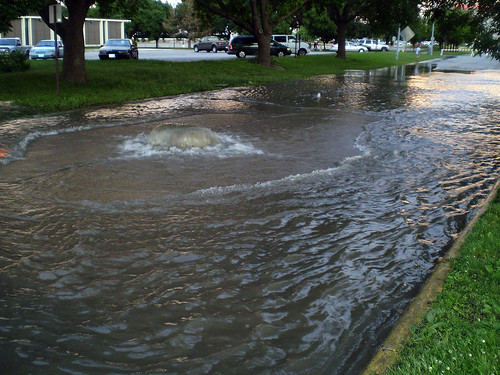Question: What can be messier than having the Green River run through your living room this winter?
Answer: Having Metro’s brown river running through you living room this winter.

A manhole cover in Des Moines Iowa get’s displaced by floodwater.
Photo by Jake Bauma (some rights reserved).
With the damage to the right abutment of the Howard Hanson Dam, there has been lots of talk about homeowner’s insurance, levee improvements, sandbags, pumps, and other precautions that cities, businesses and homeowner’s might take to minimize damage if the Green River floods.
I have not seen as much focus on another key safety device that would be highly recommended for many homeowners: sewage back-flow prevention valves.

Schematic of simple sewage back-flow preventer. Image thanks to City of Fort Wayne, Indiana
If your home is on the flat-lands, surrounded by hills, it may be a good candidate for a backflow prevention valve. This would be especially true if your home is less than ten feet above the elevation of the Metro treatment plant in Southwest Renton.
This is because the sewage that leaves your home, and that leaves the homes on the hills around you, travels by gravity to the Metro treatment plant. After all, everybody knows that *ahem* “sewage” flows down hill. But if the sewage reaches still water, it will stop flowing toward the plant. And when it stops flowing toward the plant, it can turn around and start making its way toward your house.
Planners are predicting that in a worse case flood of the Green River, the Metro plant could end up being on an island, with flood waters as deep as 10 feet on some of the streets surrounding it. Unfortunately, when streets get flooded, manhole covers start admitting water into the sewer system. These covers generally deflect rain, but they are not water-tight, and when they get submerged they will not keep water out of the sewer. In fact, as the sewer gets overwhelmed by storm water, manhole covers can be completely displaced by storm water… literally lifted up by the ebb and flow of the water, and then left dislodged to admit even more water.
In some scenarios, if the streets around the Metro plant all overflowed with flood water this winter, sewage from Renton Highlands, Talbot Hill, Renton Hill, and West Hill could literally start bubbling up in the homes in the lowlands. It’s nasty, and I don’t know for sure that this would happen, but it is a distinct possibility.
Your number one…and number two :-)…defense would be a sewage back-flow preventer. This is basically just an engineered check valve, which is installed in the sewer line where it exits your home.
My son and Renton Ben are working on a website for one local company that is helping outfit homes with these valves. And I’m sure there are many other plumbers that will help you to install one if your home is at risk.
If you have a home or business in the lowlands of Renton, I strongly recommend you research this a little further and consider having one of these back-flow valves installed if you don’t already have one. A sewage backup into your home would not only be disgusting, but it would be a bio-hazard as well, and obviously leave your home uninhabitable until you got it thoroughly cleaned. Finding help getting it cleaned could be very difficult if the Green River floods, since contractors and equipment suppliers would be inundated.
The effect of sewer backup in a basement is even more dramatic. Graphic thanks to City of Regina, California

Recent Comments